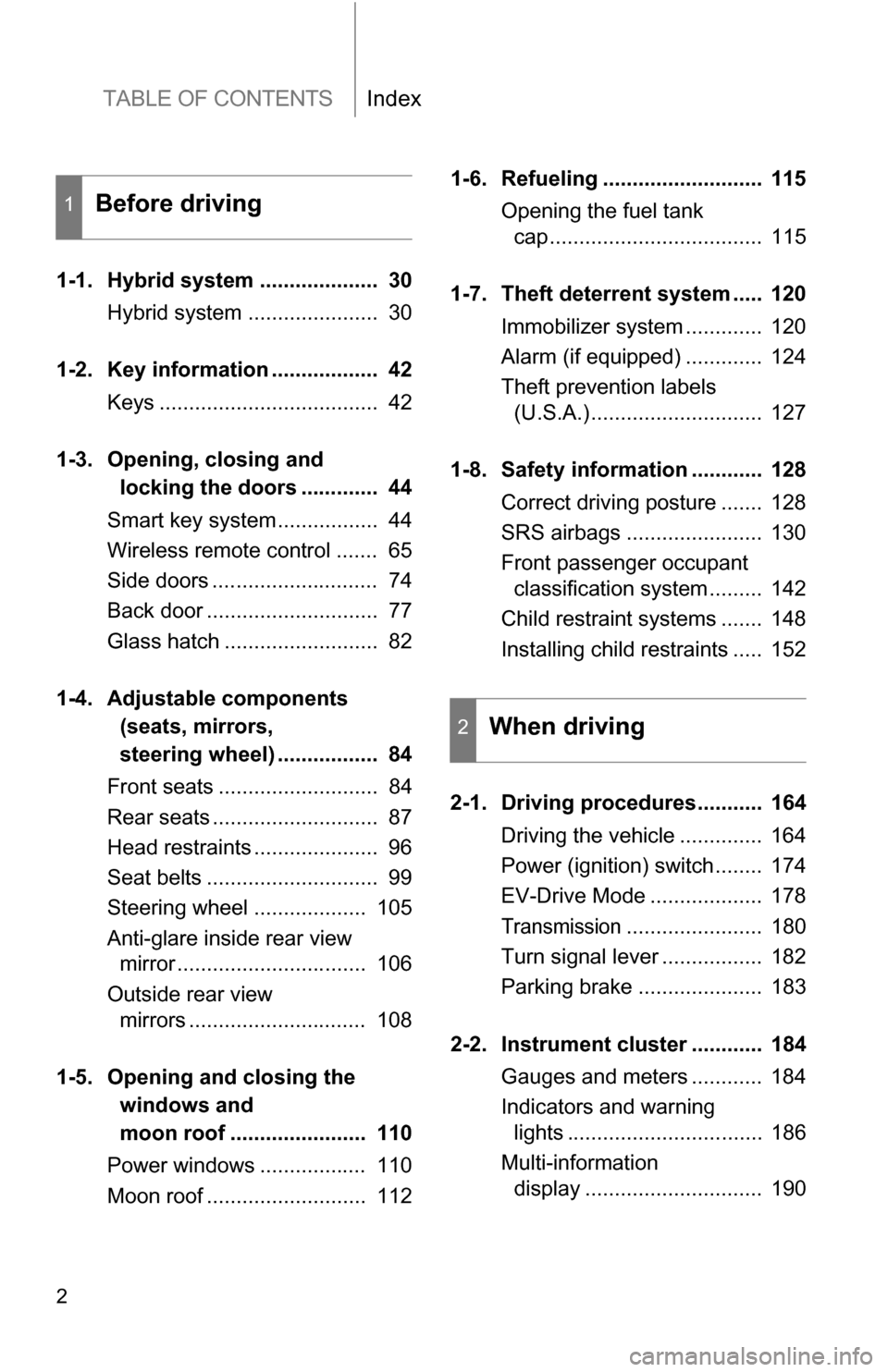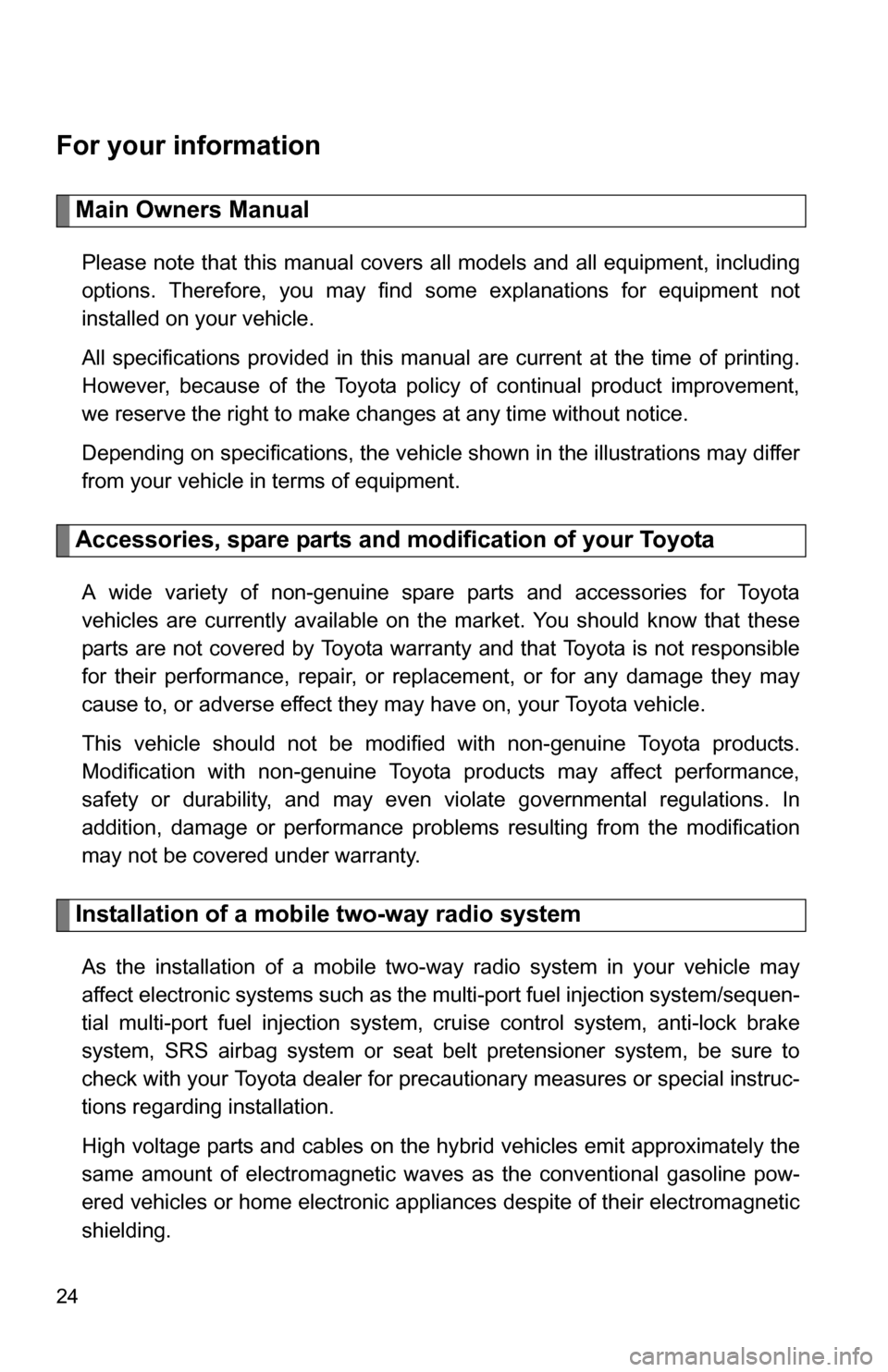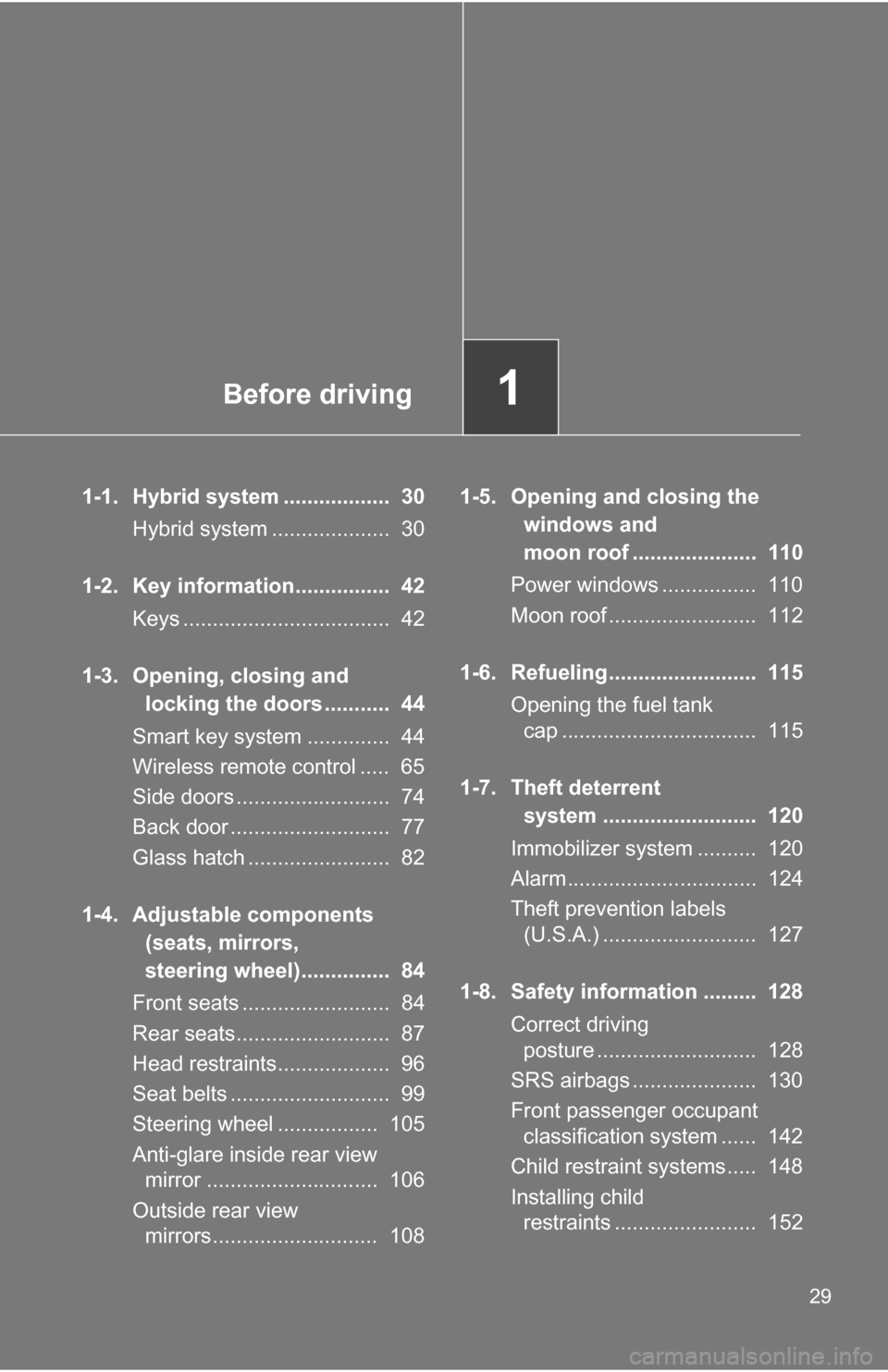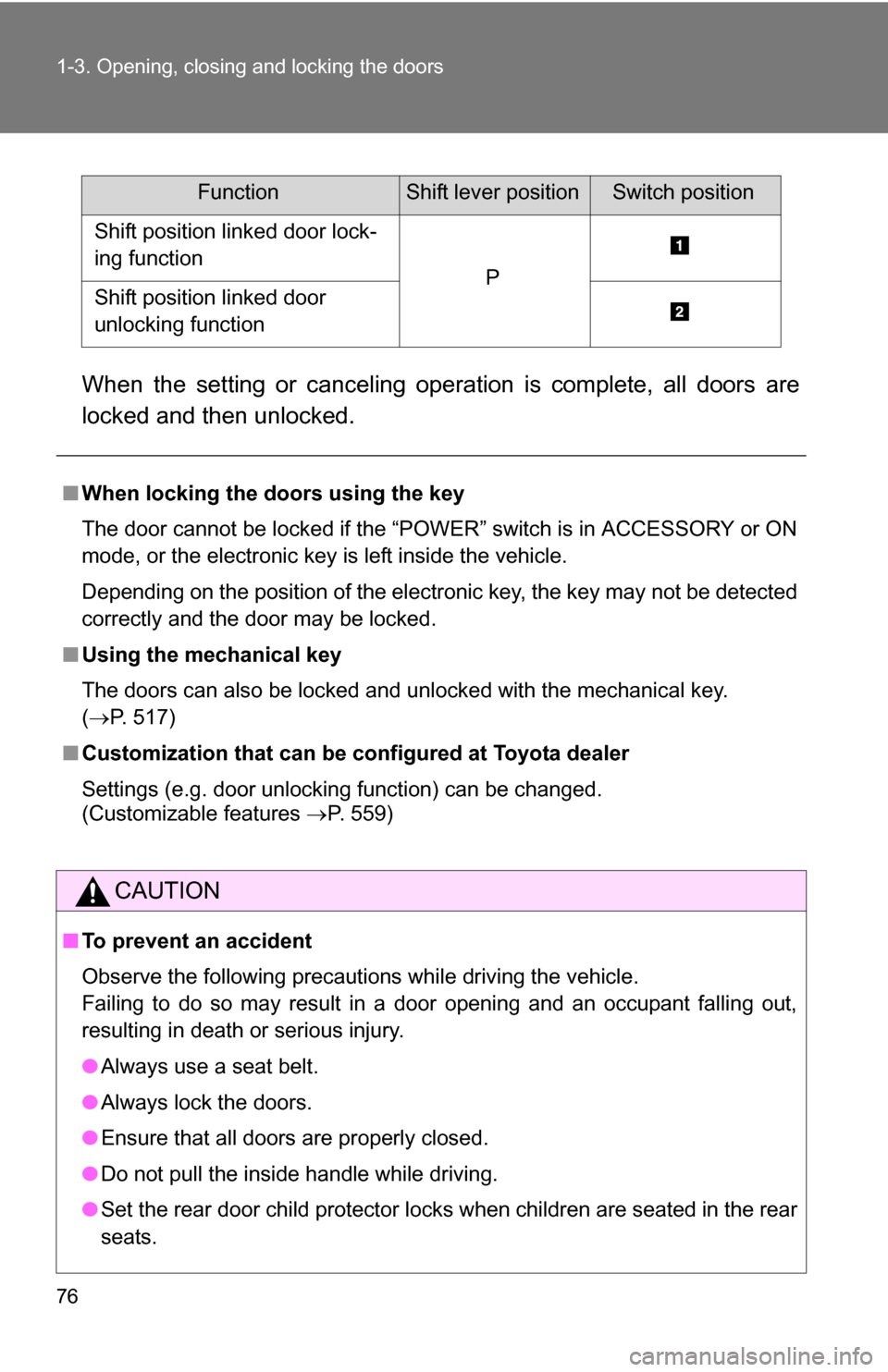Page 2 of 580

TABLE OF CONTENTSIndex
2
1-1. Hybrid system .................... 30Hybrid system ...................... 30
1-2. Key information .................. 42 Keys ..................................... 42
1-3. Opening, closing and locking the doors ............. 44
Smart key system................. 44
Wireless remote control ....... 65
Side doors ............................ 74
Back door ............................. 77
Glass hatch .......................... 82
1-4. Adjustable components (seats, mirrors,
steering wheel) ................. 84
Front seats ........................... 84
Rear seats ............................ 87
Head restraints ..................... 96
Seat belts ............................. 99
Steering wheel ................... 105
Anti-glare inside rear view mirror ................................ 106
Outside rear view mirrors .............................. 108
1-5. Opening and closing the windows and
moon roof ....................... 110
Power windows .................. 110
Moon roof ........................... 112 1-6. Refueling ........................... 115
Opening the fuel tank cap .................................... 115
1-7. Theft deterrent system ..... 120 Immobilizer system ............. 120
Alarm (if equipped) ............. 124
Theft prevention labels (U.S.A.)............................. 127
1-8. Safety information ............ 128 Correct driving posture ....... 128
SRS airbags ....................... 130
Front passenger occupant classification system ......... 142
Child restraint systems ....... 148
Installing child restraints ..... 152
2-1. Driving procedures........... 164 Driving the vehicle .............. 164
Power (ignition) switch........ 174
EV-Drive Mode ................... 178
Transmission....................... 180
Turn signal lever ................. 182
Parking brake ..................... 183
2-2. Instrument cluster ............ 184 Gauges and meters ............ 184
Indicators and warning lights ................................. 186
Multi-information display .............................. 190
1Before driving
2When driving
Page 10 of 580
10
SRS side airbags P. 130
Console box P. 365
C
Cup holders P. 368
Armrests P. 386
SRS front passenger
airbag
P. 130
Seat belts P. 99
Front seats P. 84
Bottle holders P. 372
SRS driver airbag
P. 130
SRS driver knee air-
bag
P. 130
Head restraints
Power window switches Rear seats P. 96
P. 110
P. 87
Pictorial indexInterior
Floor mat P. 387
Page 24 of 580

24
For your information
Main Owners Manual
Please note that this manual covers all models and all equipment, including
options. Therefore, you may find some explanations for equipment not
installed on your vehicle.
All specifications provided in this manual are current at the time of printing.
However, because of the Toyota policy of continual product improvement,
we reserve the right to make changes at any time without notice.
Depending on specifications, the vehicle shown in the illustrations may differ
from your vehicle in terms of equipment.
Accessories, spare parts and modification of your Toyota
A wide variety of non-genuine spare parts and accessories for Toyota
vehicles are currently available on the market. You should know that these
parts are not covered by Toyota warranty and that Toyota is not responsible
for their performance, repair, or replacement, or for any damage they may
cause to, or adverse effect they may have on, your Toyota vehicle.
This vehicle should not be modified with non-genuine Toyota products.
Modification with non-genuine Toyota products may affect performance,
safety or durability, and may even violate governmental regulations. In
addition, damage or performance problems resulting from the modification
may not be covered under warranty.
Installation of a mobile two-way radio system
As the installation of a mobile two-way radio system in your vehicle may
affect electronic systems such as the multi-port fuel injection system/sequen-
tial multi-port fuel injection system, cruise control system, anti-lock brake
system, SRS airbag system or seat belt pretensioner system, be sure to
check with your Toyota dealer for precautionary measures or special instruc-
tions regarding installation.
High voltage parts and cables on the hybrid vehicles emit approximately the
same amount of electromagnetic waves as the conventional gasoline pow-
ered vehicles or home electronic appliances despite of their electromagnetic
shielding.
Page 25 of 580
25
Scrapping of your Toyota
The SRS airbag and seat belt pretensioner devices in your Toyota contain
explosive chemicals. If the vehicle is scrapped with the airbags and seat belt
pretensioners left as they are, this may cause an accident such as fire. Be
sure to have the systems of the SRS airbag and seat belt pretensioner
removed and disposed of by a qualified service shop or by your Toyota
dealer before you scrap your vehicle.
Perchlorate Material
Special handling may apply, See www.dtsc.ca.gov/hazardouswaste/perchlorate.
Your vehicle has components that may contain perchlorate. These compo-
nents may include airbag, seat belt pretensioners, and wireless remote con-
trol batteries.
Page 29 of 580

Before driving1
29
1-1. Hybrid system .................. 30Hybrid system .................... 30
1-2. Key information................ 42 Keys ................................... 42
1-3. Opening, closing and locking the doors ........... 44
Smart key system .............. 44
Wireless remote control ..... 65
Side doors .......................... 74
Back door ........................... 77
Glass hatch ........................ 82
1-4. Adjustable components (seats, mirrors,
steering wheel)............... 84
Front seats ......................... 84
Rear seats.......................... 87
Head restraints................... 96
Seat belts ........................... 99
Steering wheel ................. 105
Anti-glare inside rear view mirror ............................. 106
Outside rear view mirrors............................ 108 1-5. Opening and closing the
windows and
moon roof ..................... 110
Power windows ................ 110
Moon roof ......................... 112
1-6. Refueling......................... 115 Opening the fuel tank cap ................................. 115
1-7. Theft deterrent system .......................... 120
Immobilizer system .......... 120
Alarm................................ 124
Theft prevention labels (U.S.A.) .......................... 127
1-8. Safety information ......... 128 Correct driving posture ........................... 128
SRS airbags ..................... 130
Front passenger occupant classification system ...... 142
Child restraint systems..... 148
Installing child restraints ........................ 152
Page 76 of 580

76 1-3. Opening, closing and locking the doors
When the setting or canceling operation is complete, all doors are
locked and then unlocked.
FunctionShift lever positionSwitch position
Shift position linked door lock-
ing function
PShift position linked door
unlocking function
■When locking the doors using the key
The door cannot be locked if the “POWER” switch is in ACCESSORY or ON
mode, or the electronic key is left inside the vehicle.
Depending on the position of the electronic key, the key may not be detected
correctly and the door may be locked.
■ Using the mechanical key
The doors can also be locked and unlocked with the mechanical key.
(P. 517)
■ Customization that can be co nfigured at Toyota dealer
Settings (e.g. door unlocking function) can be changed.
(Customizable features P. 559)
CAUTION
■To prevent an accident
Observe the following precautions while driving the vehicle.
Failing to do so may result in a door opening and an occupant falling out,
resulting in death or serious injury.
●Always use a seat belt.
● Always lock the doors.
● Ensure that all doors are properly closed.
● Do not pull the inside handle while driving.
● Set the rear door child protector locks when children are seated in the rear
seats.
Page 86 of 580
86 1-4. Adjustable components (seats, mirrors, steering wheel)
■Active head restraints
Even small forces applied to the seatback may cause the head restraint to
move. Pushing up a locked head restraint forcibly may appear the head
restraint inner structure. These do not indicate problems.
CAUTION
■Seat adjustment
●Be careful that the seat does not hit passengers or luggage.
● Do not recline the seat more than necessary when the vehicle is in motion
to reduce the risk of sliding under the lap belt.
If the seat is too reclined, the lap belt may slide past the hips and apply
restraint forces directly to the abdomen or your neck may contact the
shoulder belt, increasing the risk of death or serious injury in the event of
an accident.
● Manual seat only: After adjusting the seat, make sure that the seat is
locked in position.
Inner
structure During
rear-end
collision
Page 89 of 580
89
1-4. Adjustable components (s
eats, mirrors, steering wheel)
1
Before driving
■Getting out of the vehicle (right side only)
Lift the lever on the side of the
seatback and fold down the seat-
back. The seat will slide forward.
Move the seat to the front-most
position.
■ After passengers have entered/exited the vehicle
Lift up the seatback and slide th e seat backward until it locks.
Folding down the second seat
■ Before folding down the second seat
Stow the rear center seat belt
buckle.
Pass the outer seat belts through
the seat belt hangers and secure
the seat belt plates.
This prevents the shoulder belt
from being damage.
Make sure that the seat belts are
removed from the hangers before
using them.
STEP1
STEP2